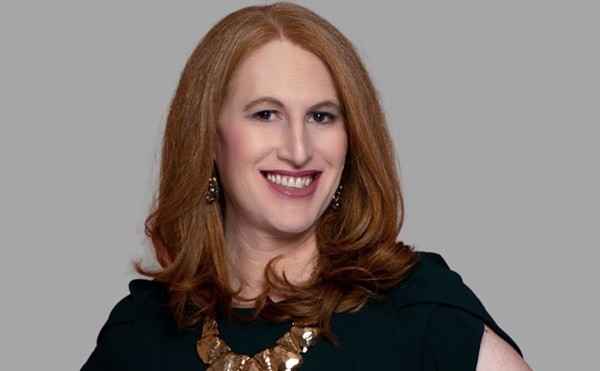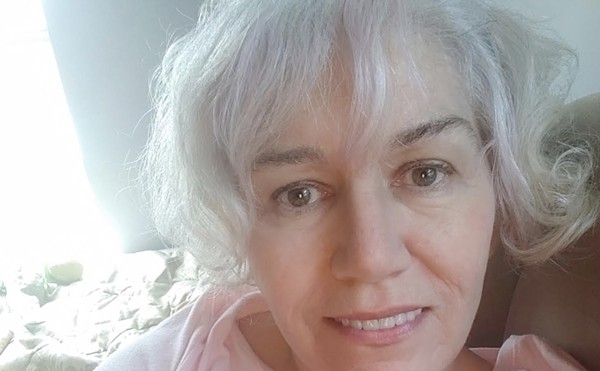The Baptists are going to love this.
Things Disney have had a special appeal for gays and lesbians going back long before "Ellen," argues Sean Griffin in his new book "Tinker Belles and Evil Queens: The Walt Disney Company from the Inside Out." In this survey documenting both the accidental and deliberate embrace of gay consumers by America's most calculating purveyor of "family values" entertainment, the film and media scholar finds enough threads to weave a pink cape for Maleficent, the villainess of "Sleeping Beauty."
The political and religious right's outrage over this affinity peaked in the mid-1990s when Disney decided to extend health benefits to the partners of its gay employees. Griffin, however, doesn't paint Disney as an unambivalent ally of gays and lesbians -- after all, Walt himself offered to make an educational film warning children about homosexual pedophiles. Instead, the gay author portrays a winking camaraderie that clearly serves to bolster the company's bottom line. Griffin spoke from his home in South Florida, where he teaches at Florida Atlantic University in Boca Raton.
Q. You open with a 1995 letter from 15 Florida legislators who claimed that Disney's domestic partner benefits undermined the company's record for representing "all that is good and pure and wholesome in our nation." That letter proves Disney may never be let off the hook by those who imagined Walt to be a moral conscience. Was he?
A. Because Disney consciously chose somewhere in the early '30s to try to be a family-friendly, kids-oriented company, it's always, even way back in the 1930s, been an easy target for attack. When "Snow White" first opened `in 1937`, various parents' groups protested it because they thought the witch was too scary. So there's a history of people complaining. Not that the people complaining are wrong all the time. It's just part of what happens when you choose to market yourself with this image.
It was a good marketing decision in the '30s. At the time, there were calls for federal censorship in films. The early Mickey Mouse cartoons show him as a ne'er-do-well, someone who's not afraid to use violence `or to` chase Minnie around the couch. Since he was such a big star, some parents' groups started getting on his case then. So there was a conscious decision to shift over into a more family image that would help him maintain popularity. Since Disney was a very small company -- not a major studio, just a little cartoon factory -- that helped gain publicity that put him on more of a par with the big studios. It helped him gain more power by deciding to fashion this image. It was economics more than anything else.
Q. Gay and lesbian historian Allan Berube found a photograph of a gay bar in Berlin from the 1930s called "Mickey Mouse." What's the connection?
A. During this early period within at least some gay communities -- there wasn't an organized community with mass media and journals and all that stuff we have now; communities were sort of circumspect and closeted -- some were using the term "Mickey Mouse" as a code word, or slang, for talking about being gay or lesbian. The idea of Mickey Mouse -- the way it's used in slang in general, as meaning offbeat, possibly a little tacky, strange -- would fit for the idea of a sexual orientation that was considered not normal. But it also sort of validated it, since Mickey Mouse was such a huge star at that point -- sort of awkward and offbeat, and yet fabulous at the same time.
Q. Much of the early appeal of Disney's films for gay and lesbian viewers seems to come from a subversive reading. Were story lines and characters actually so ambiguous that anyone could read into it whatever they wanted?
A. You can't just create a whole bunch of new characters and a whole new story line out of nowhere to fit your needs. But, especially with Disney cartoons that focus so much on fantasy, where cookies or cakes or insects or animals take on human characteristics, you're already being asked to read into things. Since the cartoons are asking that already, it might be a stretch to some heterosexual audiences, but not necessarily to gay audiences, to further say, well, why can't you read somebody as being gay? Part of the fun for gay and lesbian audiences back then was being aware that this was not the intention, that they were doing something that the makers didn't realize -- they were sort of taking some power back. That's not necessarily the case nowadays, where people working in the studio who are openly gay have said that they've been aware of the possibilities.
Q. The 1937 Oscar-winning short "Ferdinand the Bull" depicts an effeminate bull who is content to smell the flowers rather than chase more masculine pursuits. You cheer the story line as one among many that champion "outsiders," one of the ongoing themes that speak to gay sensibilities. I would have thought such a stereotypical portrait would produce outrage.
A. Because it's animals instead of human beings, there's a cushion there. It's played as sort of gently , so he's not looked on as some inordinate hero for standing up to things; he's not like some gay teen trying to get through high school. While he's content to be lazy and sit there and smell the and not be out playing sports, there's no scene of him mooning over some other bull. That might have made it OK and possibly kept most audiences from being upset.
Q. It sounds like it's not the audience but the animators who are being subversive. How could Walt not have caught on?
A. It's hard to imagine from where we are now, but people could actually not be aware that homosexuality was going on. I don't think Walt was not aware of that, especially living in Southern California `and` working in the film industry. But because of the sort of primacy of the heterosexual-lifestyle mandate, especially back then, when everybody's automatically straight until somebody begins to point out they might be something else. With that basic assumption, stuff is going to go by unless somebody says, Hey, did you notice Ferdinand's possibly a little fruity? I had that happen in a class yesterday when I showed "The Lion King" and mentioned that Skar has been read as a gay character. Pretty much the entire class was like, "What are you talking about?"
Q. Can you draw a line between those who are on the side of the gay audience, and those who are making fun of it?
A. Whenever you're dealing with animation, to a certain extent you're dealing in caricature, so you're just sort of asking for trouble when you're trying to draw male or female or various ethnicities or racial groups. That fits into dealing with stereotypes of sexuality, like when the genie in "Aladdin" dresses up as the swishy tailor. How to solve that, I don't know -- how you can animate and not be dealing in stereotypes to a certain degree. This happens in terms of camp in general, not just in dealing with Disney. Gay male camp often walks hand in hand with drag culture. Whereas there's a celebration of these female stars that they're imitating, drag has also been critiqued and analyzed by feminist critics as being hateful towards women. Is it positive? Is it negative? Stuff like that is, I think, somewhat simplistic, almost the equivalent of "thumbs up," "thumbs down," which doesn't really tell you more than yes or no instead of dealing with the complexity of these things. Are they stereotypical? Yeah, probably. But how are they being used? What are they being used for? How are they being regarded?
Q. And?
A. The genie pretty much went over fine in "Aladdin." Things seemed to be a little split among gay men over "The Lion King." A lot of people, to a certain degree including myself, had problems with Skar as possibly a gay character, as well as the idea that the heterosexual lion is the person who has the divine right to lead the country, and as soon as Skar takes over, the ecosystem immediately falls apart -- like, "These people cannot run the country!" But I know a number of gay men who really liked "The Lion King" specifically because of the story line of the son having to come to terms with the memory of his father, and being outcast, and trying to live up to his father's expectations, which are various issues that a lot of gay men have to deal with.
Q. Walt himself apparently fired actor Tommy Kirk in 1961 over growing awareness of his homosexuality. But by the 1970s the studio was making movies starring a loinclothed Jan-Michael Vincent, who you say was then a main pin-up poster boy among gay men.
A. But they're still G-rated movies: Jan-Michael Vincent is just doing a sort of teen "Tarzan." It isn't really until the changeover at the company, when Michael Eisner and Frank Wells and Katzenberg start working for the studio, that you get a concerted changeover. "Down and Out in Beverly Hills" was the first film for Touchstone Pictures under this new regime, and they made certain that it would get an R rating. The introduction of homosexuality -- where you can't necessarily read it any other way -- also happens with "Down and Out in Beverly Hills." They never actually use the word "homosexual," but the teenage son of the Beverly Hills family seems to be having trouble conforming to gender norms. He's wearing makeup and has that sort of '80s Boy George/Erasure type of gender-bending going on -- and has something that he's trying to tell his parents but seems too beat up inside to be able to say anything. At the end he seems to have transformed through his interaction with the bum that they adopt, and he introduces all his similarly gender-bending friends, including Alexis Arquette, who nobody knew who he/she was at that point, but who's now pretty famous within gay culture for his drag act. It's impossible for any audience -- not just a gay audience that's in the know, but for any audience -- to watch the movie and not, in order to make sense of the story, understand the son's character as wrestling with ideas of sexual orientation.
Q. Your analysis gives great weight to producer and lyricist Howard Ashman -- who died of AIDS complications after his work on "Beauty and the Beast" -- as a direct link between Disney's narratives and its gay audience. What empowered him to make strides that the company had not made previously?
A. Ashman and his songwriting partner, Alan Menken, had already had some success off-Broadway with "Little Shop of Horrors." Ashman had always been fascinated by Disney, and so when Disney needed somebody to help refashion their animated output, Ashman seemed to quickly jump into the breach. The popularity and critical regard of "The Little Mermaid" ensured that as long as Ashman and Menken wanted to work for Disney, they were going to let them.
Ashman, beyond just writing the words to the songs, was promoted to co-producer of the films he was involved in, and even for "Beauty and the Beast" had a hand in helping fashion the script. Although it'd be nice to say they saw Ashman as a wonderful talent and wanted to foster him and said, "Here, you want to input these gay things into it, that's great," it was basically economics. They wanted to strengthen their animation department, Ashman was there and proved that the ideas he had were box office, and so they said, "Keep going." And that allowed him some power to not necessarily input gay-coded messages, but to fashion stories that would appeal to him. And since he was a gay man, a number of the various messages of "The Little Mermaid," "Beauty and the Beast" and "Aladdin" would have special resonance for a gay and lesbian audience as well.
Q. Disney is not so much coming around to accept gay culture so much as recognizing that the demographic has dollars to spend. Should gay and lesbian communities feel used by Disney?
A. In a capitalistic system, unless you're willing to foment the revolution, this is the way things work for all minority groups. In order to get representation and get noticed, you have to move up in the economic scale. I feel it's better to have some representation and some awareness rather than nothing, even as problematic as the recognition may be. Disney is not the only one out there looking to the gay and lesbian community as a market, instead of dealing with the various social and political issues. One of the main reasons Disney decided finally to give domestic partner benefits was because almost all the other major studios were doing it, and Disney wanted to stay competitive.
Disney is still trying to maintain its image as family-oriented company. It's never been, "OK, we're going to stop wooing the gay and lesbian consumer," but "How can we do this without jeopardizing the other consumers?" And so it's always been, give a little here, then step back and wait to see if anything blows up, which is one of the reasons why they took so long with domestic-partner benefits. With the gay days and gay weekends at the theme park -- which aren't specifically organized by the Disney company -- Disney has some deniability. It's like anybody who gives us money, we'll take the money; what they're doing there, as long as they're not pulling out guns and killing people, or having sex right there on the rides, they don't necessarily care.
Q. Given Disney's success at target marketing, will we ever see a commercial that depicts two adult men holding hands on Main Street, USA?
A. No, because I think to a certain extent there still is an attempt at deniability. If there is advertising that might be aimed at gay or lesbian people, it still tends to be what I refer to as "gay window," where a gay audience can read into it, but the heterosexual audience -- with that sort of natural assumption that everyone is straight until you tell me otherwise -- won't get it.
Q. You realize, of course, that you've given the conservative lobby and religious right activists a whole new round of ammunition.
A. That was something people warned me about -- like I'm letting the cat out of the bag. But what I tried to do is point out that this is not necessarily some huge victory for the gay and lesbian community. There is a measure of exploitation going on. It isn't necessarily that Disney or any of other companies that are giving domestic partner benefits or becoming more aware of gay and lesbian concerns are in the trenches, marching the marches, doing the sit-ins, signing the petitions. Basically it's all down to economics. If there was not a concept that there were dollars to be made from this, none of this would be going on.
This article first appeared in the online magazine Salon
















